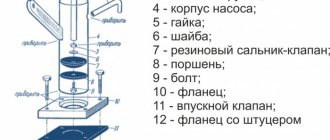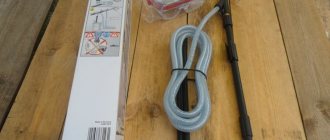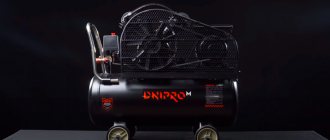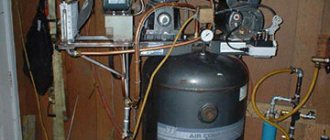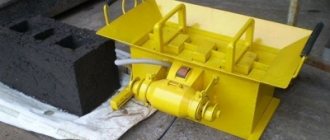The nozzle, which is used to equip a sandblasting machine, is the most important design element of such a device. Only a correctly selected nozzle will allow you to most effectively use the sandblaster for its intended purpose: to clean various surfaces from dirt, old coatings, traces of corrosion, degrease them and prepare them for further processing.
For each application, you can select a nozzle of a certain diameter, depending on the fraction of sand used
The tasks that a sandblasting nozzle solves are to compress and accelerate to the required speed a mixture consisting of air and abrasive material, as well as to form a working spot and saturate it with abrasive acting on the surface of the workpiece. Depending on the size of the surface to be sandblasted, different types of holes can be made in the nozzles. Thus, for processing narrow surfaces, nozzles with the same diameter along the entire length are used, and for cleaning large surfaces, products are used, the holes in which have larger diameters at the inlet and outlet (Venturi type, developed in the middle of the last century).
Design and operating principle of sandblasting
A sandblasting machine is a special device designed to remove rust and corrosion from metal and concrete surfaces. Structurally, the unit consists of the following parts:
- containers for abrasive material;
- a compressor that pumps air under pressure;
- nozzles made of high-strength material through which abrasive is supplied;
- thick rubber hoses connecting parts of the structure.
The operating principle of the device is simple. When the unit is turned on, the compressor supplies air under pressure directly into a container with abrasive or into a special chamber. The mixture passes through the hose to the nozzle of the sandblaster and flows out through the tip with a powerful jet. Upon contact with the surface being treated, rust or old paintwork is quickly removed.
Sandblasting machines can be domestic, up to 20 liters, and industrial, from 100 liters or more
Attention! Sand is most often used as an abrasive for sandblasting machines, but it can also be electrocorundum, metal shot or ceramic chips.
Manufacturers
Experts recommend nozzles from the following companies:
- Contracor - Russia;
- CLEMCO - Germany;
- VMZ - Velikoluksky Mechanical Plant.
German products are known for their reliable performance and long service life. Nozzles from CLEMCO are considered the best. The company produces mainly ceramic and tungsten carbide inserts.
Sandblasting nozzles from the Russian company Contracor are not inferior to them in quality. The main products are boron carbide, tungsten and ceramic inserts are available.
VSW produces conventional nozzles at a budget price. Hobbyists can purchase a variety of attachments - metal, ceramic and cast iron for one-time repairs.
Drawings and diagrams of sandblasting from a bottle
You can build a sandblasting machine at home from scrap materials. The easiest way to make a device is from a regular plastic bottle. The circuit diagram of the device is very simple. The bottle serves as a reservoir for sand, and in the upper part a structure is attached to it that is directly responsible for supplying the abrasive.
In a sandblasting machine from a bottle, it is necessary to ensure the release of abrasive and the supply of compressed air
Most often, a homemade unit is created based on a compressor and a blow gun. There are also instructions for making the apparatus from a gas cylinder, fire extinguisher and other consumables. In all cases, the device is compact enough for home use.
The air supply for homemade sandblasting should be carried out at a pressure of 3 to 8 bar
A homemade sandblasting machine is a device with modest characteristics and does not demonstrate high power. But for home use it is sufficient.
Hydrosandblasting
Hydrosandblasting can be carried out regularly in a normal garage or on-site environment, also using regular PPE. The bodies of old cars, after cleaning with hydrosandblasting, are quite suitable for painting; distance of the site or workshop from the above objects - from 50 m. Hydrosand jet is used without a compressor from a portable car wash or household “sprinkler” for windows and display cases
Therefore, special attention should be paid to hydrosandblasting
The design diagram of a hydrosandblasting installation driven by a portable washing machine is shown on the left in the figure:
Diagram of a hydrosandblasting installation and a simple nozzle for hydrosandblasting
A drawing of a simple nozzle made from parts of a water supply system for hydrosandblasting is on the right; The inset shows its appearance. The operating principle is ejection. However, such a nozzle works with some washers, but not with others, and the limits for adjusting the jet density and abrasive flow rate with a suitable drive are insufficient. The reason is the oblique concentrated supply of the abrasive-air mixture to the ejector.
The nozzle with coaxial supply of water and abrasive-air mixture works stably with any car and household washing installations. For example, the nozzle, the drawings of which are shown in Fig., was originally developed for the Kärcher car wash. But it is also suitable for any other thread with a standard G1/4” tip. And if the standard fit is different, then it is enough to make a connecting socket for it (see item 1).
Drawings of a universal hydrosandblasting nozzle for portable washers
How to make a hydrosandblasting nozzle for a portable car wash, see also the video:
What tools and materials will be needed
The set of materials and tools for a sandblasting machine depends on what available means the device will be made from. To construct a unit based on a blow gun, you will need to prepare:
- plastic bottle 1-1.5 l;
- a compressor designed for a pressure of about 5 bar;
- blow gun;
- reinforced hose;
- glue gun;
- drill;
- file;
- sharp knife;
- marker for marking.
If you make a sandblasting machine based on a compressor and a conventional sprayer, the list of tools and materials will be slightly different. You will need to take:
- glue gun;
- plastic bottle 0.5 l;
- compressor with low power ratings;
- drill;
- inexpensive sprayer;
- Teflon tape;
- file;
- coupling for transition from external to internal thread;
- knife.
In all cases, when creating a home apparatus for removing corrosion, it is also necessary to prepare an abrasive material in advance. For homemade devices, sand is usually used.
How to make sandblasting from a plastic bottle and a compressor with your own hands
To create a sandblasting machine based on a bottle and a compressor, you will also need to purchase a sprayer. It is necessary for direct supply of abrasive material to the surface being treated.
Preparing the Sprayer
To make a sandblasting machine, it is recommended to purchase a sprayer with replaceable nozzles. If the original tip is the right size for the device, you can keep it. But a nozzle that is too small will be easy to replace if necessary.
The algorithm for preparing the sprayer for use looks like this:
- Before installing the nozzle, an adapter from external thread to internal thread is installed on the device. This will prevent the abrasive jet from dispersing. To change the thread, use a transition coupling with a diameter of 1 cm.
- To make the connection airtight, the adapter is wrapped with Teflon tape in a clockwise direction. The joint is securely tightened with pliers to eliminate any backlash.
- The sprayer is lightly clamped in a table vice and using a grinder with a cutting disc, approximately 0.6-1.3 cm is removed from the length of the nozzle.
When cutting a hole in the tip, it is necessary to apply preliminary markings very carefully. The length is removed with extreme care, since the sander often picks up excess.
It is not recommended to saw a large hole in the tip, as this will increase the consumption of abrasive
Making a tank
You can turn a plastic bottle into a sandblasting tank using the following scheme:
- Using a sharp knife, remove the colored ring remaining from the lid on the neck of the container.
- In place of the removed part, a through hole is made with a 3 mm drill.
- Expand the hole using a 4.8 mm nozzle.
After this, the bottle is turned upside down, abrasive is poured through the neck and the cap is screwed on tightly. The vessel must be filled to the top, but slightly short of the hole made.
Attention! When drilling a bottle, hold the drill at a right angle of 90 degrees. The hole should be as smooth as possible, without bevels.
To make drilling the hard neck of a bottle more convenient, the container should be carefully clamped in a vice
Assembly and design testing
At the last stage, all that remains is to connect the parts of the sandblasting machine to each other. They do it like this:
- Insert the nozzle into the through hole made in the bottle.
- Treat the joints with hot melt adhesive to seal.
- Connect the sprayer to a compressor with a low power of 3-5 atm.
- The design is tested in operation on a small surface area.
Using a homemade bottle-based sandblaster, it is convenient to clean rust from small metal parts.
Videos about do-it-yourself sandblasting from a bottle show that the home device has low power, but it still leaves a lot of dirt during use. When working with the device, you need to wear protective clothing, goggles and a respirator.
Main types of compressors for sandblasting machines>
There are mainly 2 types of compressors used in sandblasting machines:
- screw;
- piston
In most cases, when manufacturing independently, preference is given to piston options. These compressors are characterized by high performance, but the air is supplied into the main line in certain bursts. To eliminate this problem, an additional receiver is installed.
Screw and piston compressors are used in sandblasting devices.
Some users also note that piston devices sometimes have problems with oil supply. This leads to the appearance of moisture-oil condensation. The consequence of this nuance is the formation of lumps in the abrasive material, which can lead to tool failure.
The operating principle of a sandblasting machine with a screw compressor is somewhat different. Here, the device is based on 2 worm-type gears, rotating in different directions. The main advantage is the absence of noise and unnecessary vibrations. It is for these reasons that if you plan to assemble a mini sandblasting machine for home use, it is better to choose a screw compressor.
Based on the type of power supply, compressors are divided into diesel and electric. Each option has its own advantages and disadvantages. If you plan to assemble a small mobile device, it is better to give preference to the diesel option, the main advantage of which is that it is not connected to a 220 V network.
Accordingly, the device will be convenient to carry around the site, for example, to remove paint from a fence or gate. Another advantage of a diesel compressor is the ability to automatically control engine speed. This makes it possible to regulate and save fuel consumption.
When making sandblasting yourself, preference is given to piston compressors.
The advantage of an electric compressor is lower fuel costs, but there is always a connection to the presence of a power outlet. It can be used at any temperature, while to operate a diesel appliance in frosty conditions, you will have to additionally purchase a cold start and preheating unit. Diesel engines really don't like low temperatures.
If you want to save as much as possible, you can make the device yourself using available components. In particular, ready-made compressor heads, which are removed from the pneumatic brake equipment of such cars as ZIL and MAZ, are suitable for work. They can often be found at old salvage yards, flea markets or on classifieds websites. For normal operation of the head, you will need to equip it with a receiver, as well as a frame for convenient fastening of other structural elements.
Sandblasting with a blow gun and bottle
The most popular algorithm for manufacturing a sandblasting machine suggests using a blow gun paired with a bottle. To build up pressure, you will also need to take a low-power compressor.
Bottle preparation
As in the previous case, a plastic bottle must be converted into an abrasive tank. The algorithm is as follows:
- The ring is cut off from the neck of the vessel and the bottle is clamped in a vice.
- In the toughest part of the container, a through hole is drilled in place of the former plastic strip.
- Thread the nozzle of the blow gun into the prepared holes to ensure that the dimensions are correct.
The diameter of the drill must be selected in accordance with the width of the tip. It should not slide freely in the holes.
An alternative option is to drill holes directly into the hard cap of the bottle.
Blow gun treatment
The blow gun is perfect for spraying abrasive and requires minimal modification. Necessary:
- Clamp the tip in a small vice.
- Using a file or grinder, cut a hole about 1 cm in length.
After assembling the structure, the abrasive mixture will flow into the hole made.
A hole in the gun nozzle is made closer to the junction of the tip and the tool
Sandblast assembly
After modifying the blow gun and bottle, all that remains is to assemble the sandblasting device together:
- Pour abrasive into the container.
- Screw on the cover if it is removed.
- Insert the nozzle of the gun into the holes of the bottle and seal the leaky areas with hot glue.
Next, the blower is connected to the compressor and the device is put into operation. When using a sandblasting unit, the bottle must be on top of the gun so that the abrasive under its own weight can fall down and enter the nozzle.
When working with home sandblasting from a bottle, you need to use the finest sand possible.
How to make sandblast from a bottle without a compressor with your own hands
Most algorithms recommend using a compressor to create a sandblasting machine that provides the device with acceptable power. But if you wish, you can make the device using a spray gun. The algorithm looks like this:
- The spray gun is pre-bored to increase the diameter of the outlet hole.
- A mixing tee is attached to the device and the gun is connected to a plastic bottle with sand.
- Secure the supply and circulation hoses.
The design is activated by pressing the trigger of the spray gun. Surface treatment occurs in pulse mode.
Attention! A spray gun with a 1-1.5 liter plastic bottle is enough to clean metal parts for about half an hour.
Sandblasting from a hand-held spray gun works on the principle of a mechanical spray gun.
Recommendations
Assembling a sandblasting machine based on a plastic bottle is not particularly difficult. When manufacturing the device and when working with it, you need to pay attention to several points:
- Reliability of fastening elements. All parts of a homemade unit must be firmly connected to each other.
- Suitable pressure. If the compressor supports adjustment, you must first make sure that the sandblasting power settings are set to medium.
- Safety. Even with a compact unit you cannot work without a respirator and safety glasses. Flying grains of sand can get into your eyes; it is strictly forbidden to inhale the resulting suspension.
When using a sandblasting unit from a plastic bottle when cleaning surfaces, the nozzle is directed at an angle of 90 degrees to the metal parts. If you need to remove paint, the tip should be positioned at an angle greater than 90 degrees.
Types of structures
Types of sandblasting units vary depending on the task at hand. If you need to decoratively process glass, it is advisable to use a sandblasting chamber. To clean parts, an open type device is used. An open type sandblasting machine (depending on how the abrasive is supplied) is divided into several types:
- pressure;
- injection.
The pressure apparatus supplies air inside the unit, as well as into the dispenser of the sand container. The air flow will move, and then the compressed gas will enter the hose with a nozzle. The nozzle will determine the shape, as well as the pressure of the jet. This type of machine is usually used to process large surfaces and can be used for many hours.
The injection apparatus differs in that sand and air will move through different hoses. As a result, a small pressure will be created, which is suitable for short-term work.

